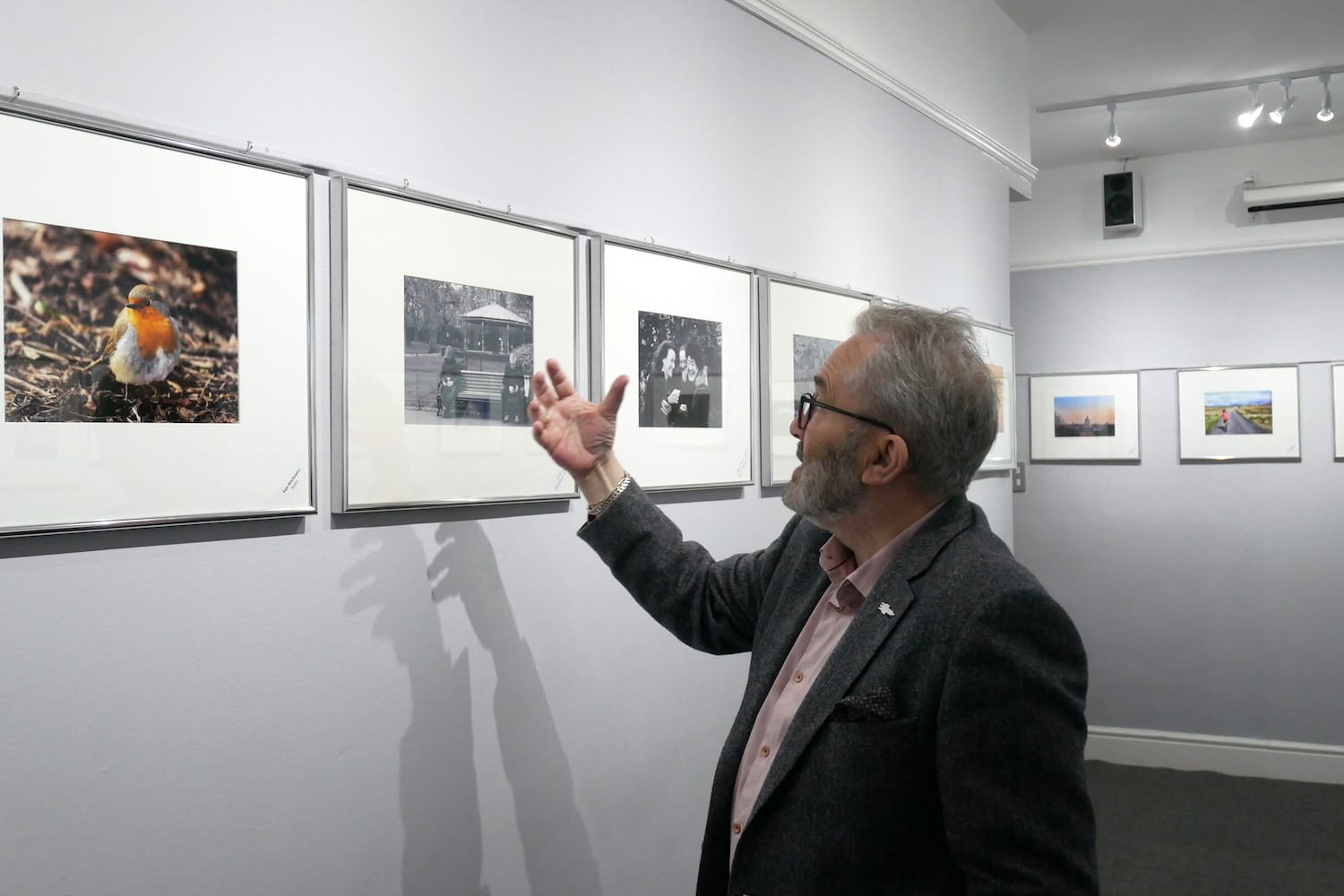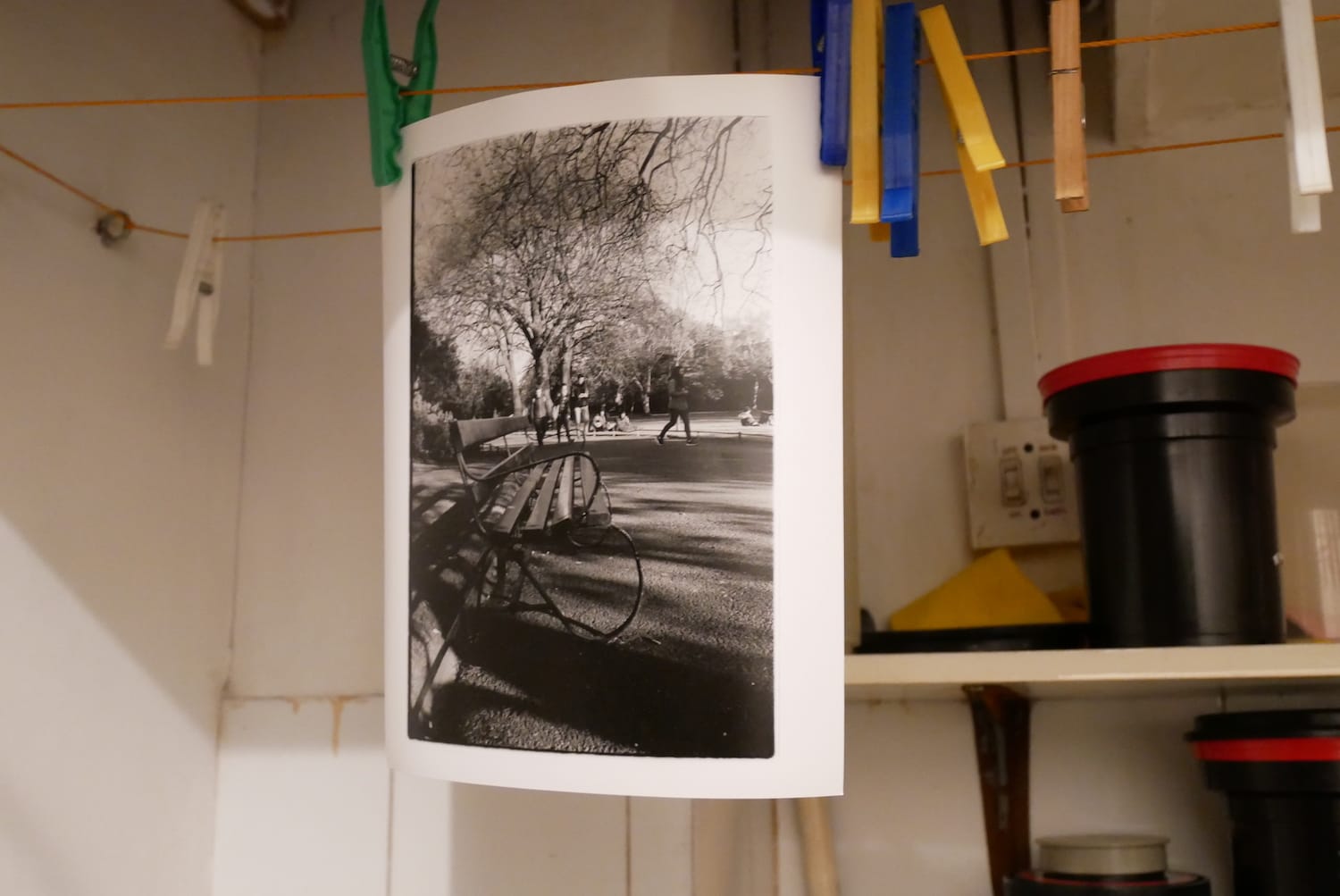What’s happened with Manna’s plan to expand its drone delivery service across Dublin?
It still only has one base, in Dublin 15, with planning permission – and that’s due to expire this year.
Founded in 1945 to cater to amateur photographers not quite ready for the heights of the Photographic Society of Ireland, Dublin Camera Club currently has more than 150 members.

Tony Davis’ favourite image on display at the Dublin Camera Club gallery is of a vibrant blue bench against a sooted stone wall.
It’s the contrast that makes the photo, says Davis, the club’s president. “You can tell they have a good eye.”
Dan O’Connor, a club member, favours the one next to it. It shows two men on opposite ends of a bench, both engrossed in their mobile phones.
Each month, the images on show here on Lower Camden Street change. These were taken by members of the club’s beginners’ course.
Anyone with a digital or film camera can join, and sign up for courses and workshops here, says Davis.
Summer is a busy time for members. The club’s annual exhibition, with 150 images, launched in Pearse Street Library on Tuesday night (4 June). It will be on until 28 June.
An expanded show will move to Custom House Quay for two weeks in July, too.
Founded in 1945 to cater to amateur photographers not quite ready for the heights of the Photographic Society of Ireland, Dublin Camera Club currently has more than 150 members, says Davis.
Its headquarters covers three floors on Lower Camden Street, where the club has been since 1990.
There are two darkrooms with chemicals and trays. There’s a studio full of props on the second floor. Upstairs, there’s a room for meetings, and a bright yellow room where members can enjoy a cup of tea.
It’s a well-equipped club compared to some others in Dublin that have to rent spaces, says Davis.
The in-house Eddie Chandler Gallery – named after the late long-time member of the club – is what he is most proud of, he says.
The small ground-floor room, open on Saturdays from 11am to 2pm, holds a rotating exhibition, which changes each month.
Right now, it’s the novices’ exhibition, where students of the beginners’ course show what they’ve learned.
There are crisp images of park benches, cats, portraits, and runners tied to a telephone line.
“I don’t want to say we’re surprised, but we are pleasantly delighted that they turn out so well. They’re stunning,” says Davis.

Each year, the club runs two 10-week beginners’ courses – one kicking off in September, the other in January. (It’s €120, and those who sign up can get a discounted yearly membership for €50 more.)
On Monday evenings, there are workshops on photo-related skills from mounting pictures to editing on Photoshop to using the darkroom.
New joiners are ranked as novice, intermediate, or advanced – depending on distinctions or awards they might have. Members climb the ranks as they submit photographs to competitions.
Novice member Dan O’Connor says in the past, he mainly took photos at family events or holidays.
Last year, though, he bought a Panasonic Lumix GX800 and researched courses in Dublin to learn how to use it.
He quickly upgraded from the beginners’ course to full-time member. “Right from the very beginning after a couple of classes, I knew that I wanted to do this,” he says.
Davis says the club is a great way to meet people and to share advice. It runs walkabouts and outings led by mentors.

Competitions are where you really begin to develop as a photographer, says O’Connor.
Each month, from October to March, members submit a photo for the winter league.
In O’Connor’s first year, he submitted a landscape taken in Donegal. “I had lots of different textures, different shades of green. It didn’t look great.”
The guy adjudicating said he should switch it to black and white. ”It was a different photograph,” O’Connor says.
He came second in the novices’ winter league with one, he says. “That tells you how much I learned.”
Says Davis: “Some people really take it seriously. The judges are often slated when we come upstairs for a cup of coffee afterwards … You get a kicking.”
One club member took an image and put it in every competition to see how it did.
“It did everything from being last to first and everything in between,” Davis says. “It just shows you how subjective it is.”

Portraiture is popular with those in their mid- to late 20s, says Davis.
“They want to know the commercial side of photography,” he says. How to get a release form for models. What to consider in contracts. How to run exhibitions.
They’re also bringing film photography back into fashion, he says. Software like Photoshop or Lightroom is still more popular than the darkroom. “But there are people who don’t like digital. There’s more of a craft to it.”
Sorting through a stack of photographs, Davis picks out a portrait of a boy in India. “This is a very typical image,” he says. “It’s a very Dublin Camera Club photo.”
Travel, portraiture and street photography are popular, but Davis wants to see the club broaden.
He’s a fan of abstract art, he says. That’s what what made him take up photography when he retired from banking four years ago.
Abstract photography means taking images up close, capturing patterns.
“One woman often does bubbles, She takes pictures of the colours,” he says. “I did a series on the cracks on the walls here.”
In the next few months, the club will host two exhibitions run by Fédération Internationale de l’Art Photographique (FIAP), a network of photography associations from all around the world.
Both will be of photos that have won awards at competitions or salons under FIAP patronage. “These are big, big awards,” says Davis.